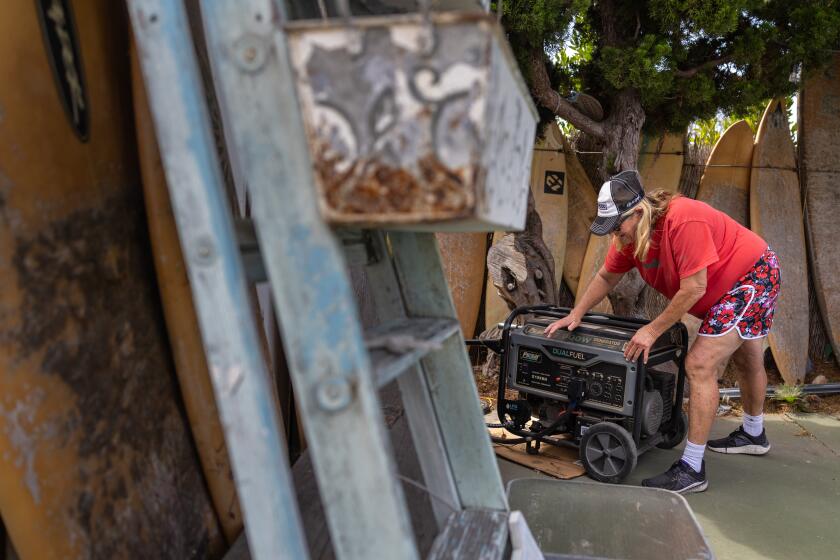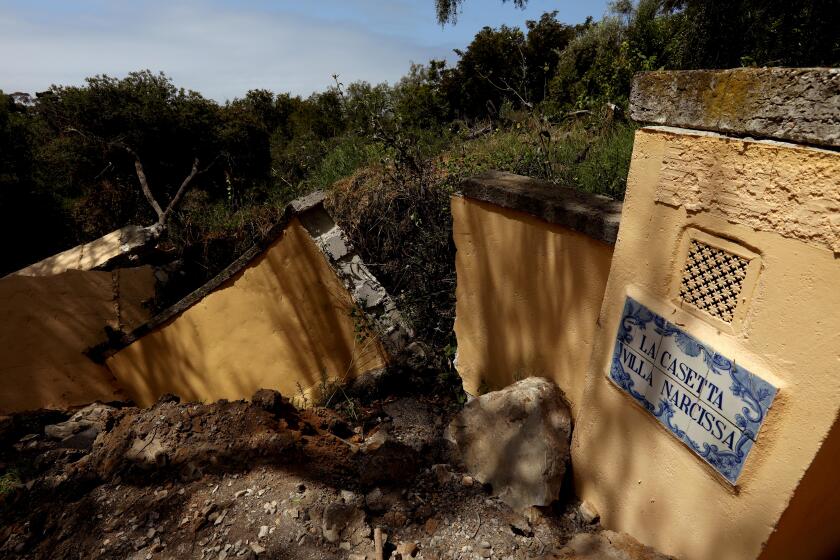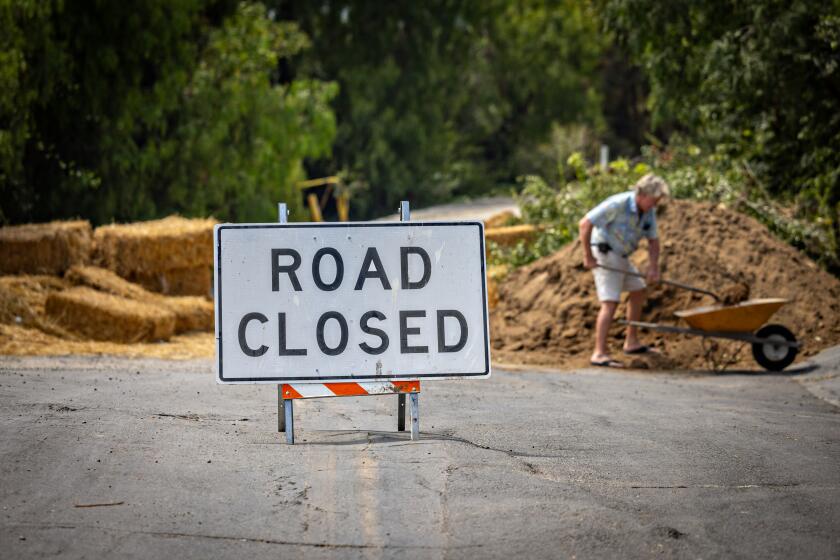Some landslide-damaged homes to be bought out in Rancho Palos Verdes, thanks to $42 million from feds

The federal government plans to give Rancho Palos Verdes $42 million to finance buyouts for the homeowners hardest hit by the ongoing landslides in the Portuguese Bend area, with the properties eventually converted into lower-risk open space.
The program, part of the Federal Emergency Management Agency’s hazard mitigation assistance grants, provides one of the first long-term solutions for residents in the landslide-ravaged region, which has for decades gone through periods of increased land movement — though the scale and speed of the movement in recent months has been unprecedented.
Officials project that they’ll have enough money to buy out 20 property owners in the Portuguese Bend area, the majority of whom face increasing property damage and indefinite utility shutoffs due to land movement. Applying for a buyout is voluntary; no one will be forced to sell their home to the city.
Homeowners can expect to receive offers equal to 75% of their property’s predisaster fair market value, before back-to-back winters of heavy rain set off the area’s complex of ancient landslides in a new way. With a goal of minimizing future disasters and related losses, the city would then demolish the homes and ensure no future development.
“This buyout program provides a viable pathway forward for our most vulnerable community members, offering the opportunity to relocate and rebuild with meaningful compensation,” Rancho Palos Verdes Mayor John Cruikshank said in a statement. He said dozens of residents had endured unimaginable losses from the recent land movement, “with some facing the real prospect of losing their homes entirely.”
Rancho Palos Verdes allocates $10,000 grants for residents dealing with damage and utility loss due to land movement. The city also will prepare for rain.
This announcement comes months after residents have pleaded for state and federal assistance amid escalating land movement that has ruined homes, required almost incessant roadway repairs and forced out utility providers. However, only a fraction of the damaged and threatened properties in the area can be approved for the buyout. About 260 homes across three Rancho Palos Verdes neighborhoods have been affected by the landslide in recent months.
Mike Hong, who designed and built his Portuguese Bend home on property he bought in 2014, is hoping the buyout will be available to him and his wife.
“What they’re offering is a lifesaver for most people, and us as well,” Hong, 65, said, although he is concerned about how much the offer would be. “It’s bittersweet — it gives us a chance to save our family’s finances, but you’re seeing the labor of love destroyed.”
Hong estimates that his home would have been worth about $3.6 million two years ago — probably on the higher end of neighborhood property values because it’s relatively new — but he says he’ll wait and see what is offered, if there is an offer.
The announcement of the buyout program follows some of the first positive news in months about the landslide. City officials reported this month that the rate of land movement had decelerated as much as 80% in some locations compared with the month prior, primarily due to new, deep dewatering wells that the city installed from August to October. The wells have pumped out millions of gallons of groundwater that drives the area’s landslide movement.
Hong said that even if they weren’t accepted for the buyout program, the slowing land movement — which led to his home being one of about two dozen that recently regained electricity — was welcome news.
“We could still ride it out, we could take our chances if this doesn’t work out,” Hong said. “Regardless, we will go ahead and put the application in.”
Living inside the Rancho Palos Verdes landslide zone: Darkness, propane, batteries and determination
Patty Perkinson is not ready to give up on her Rancho Palos Verdes home — despite the active landslide causing untold damage and now the loss of vital utilities.
Not everyone, however, is jumping at the opportunity. Sallie Reeves and her husband, who have lived in their Portuguese Bend home since 1982, have decided they won’t apply.
“We’re committed to staying,” Reeves, 81, said. “We’re pretty financially committed now.”
They are weeks into a major renovation after a fissure forced apart rooms in their home. Like several others in the area, they have put their home up on steel beams and adjustable supports, which she feels confident can now withstand any future land movement.
But Reeves said she understood why some people might be ready to take a reasonable offer to leave and start over, especially those with young kids.
“There are people here who feel trapped,” she said. “I’m excited for those who can take advantage of it.”
Marianne Hunter, 75, is on the same page as Reeves, though she notes that her home has thankfully suffered far less damage. But cracks continue to show up along her walls, floors and outdoor patio.
Still, she and her husband aren’t going anywhere, especially now that they have installed solar power — a major investment.
“We couldn’t afford to move anyplace that would be anywhere comparable to this,” Hunter said. “There’s no way that we would find property that was as serene as this can be — when it’s not moving. We love our community, we love our house.”
And for those planning to stay or who aren’t approved for a buyout, city officials said the program would not affect any ongoing landslide mitigation or winter preparedness work.
“The council wants no one to feel that this program that is being proposed to you is any indication that the city is walking away from any of its winterization or stabilization efforts,” said Ara Mihranian, Rancho Palos Verdes’ city manager. The city has installed 10 new dewatering wells and approved more than $13 million in recent weeks to prepare roads, drainage systems and other infrastructure for the rainy season.
For the buyout program, the city will prioritize the eight homes that have been red- or yellow-tagged — officially deemed unsafe to enter or unlivable, respectively. Next on the priority list will be properties with significant damage that officials believe could soon require residents to move out. Then, consideration will be given to the about 250 additional homes that remain cut off from electricity, according to city officials.
If selected, the city will purchase the property for 75% of what an appraiser determines to have been the fair market value of the land and improvements on Dec. 1, 2022, minus some of the transaction and demolition costs.
Although the buyout program is historically used for property owners in flood-prone areas, FEMA, the California governor’s Office of Emergency Services and the city have worked together to customize it for this landslide situation, Mihranian said.
According to FEMA‘s website, there is hazard mitigation funding for landslide or mudslide areas — however, the focus of the programs is on mudflow disasters, especially those that occur after a fire. The agency also lists the grants as an option after earthquakes, hurricanes, drought and other emergencies to provide “funding for eligible long-term solutions that reduce the impact of disasters in the future.”
Accelerating landslides in Rancho Palos Verdes have continued to upend life. But residents like Gordon Leon aren’t ready to give up.
Properties that are acquired by the city will be converted to open space, officials said. The city would be in charge of demolishing any structures or improvements, including driveways on the property.
“All that has to be removed, regraded, and it would be deed-restricted for open space in perpetuity,” Mihranian said.
Interested property owners must request a property inspection from the city by Nov. 4.
FEMA and Cal OES will check whether the homes seeking a buyout meet all eligibility criteria, which include a particularly tricky point for many in this landslide zone: Structures must still be on the lot for which they were legally permitted. With hundreds of feet of movement in recent years pushing houses off their original spots, it wasn’t immediately clear how many homes would no longer be eligible.
Another point that has tripped up some residents is that upon approval for the buyout, the property owner would be required to release the city and all other agencies of liability. That’s an issue for many who have sued or plan to sue for losses related to the land movement.
Homes built on land with past landslide activity are on the market. Here’s how homebuyers can assess a property’s risk to land movement.
Although city officials were pleased that FEMA and the state supported the new buyout program — approved through the federal disaster declaration for Los Angeles County after a string of devastating atmospheric river storms in February — Rancho Palos Verdes has been struggling to secure outside funds to help pay for the increasingly costly efforts to stabilize the landslide.
Mihranian said at a town hall this week that the city was running out of money, and FEMA recently denied the majority of its $61.4-million request for reimbursements for storm- and landslide-related costs. Just this fiscal year, the city is expecting to spend $32 million in landslide-related projects, much more than it spent on them in the last two years combined.
Mihranian said the city planned to appeal FEMA’s decision, and is still exploring other funding sources.
More to Read
Sign up for Essential California
The most important California stories and recommendations in your inbox every morning.
You may occasionally receive promotional content from the Los Angeles Times.
















